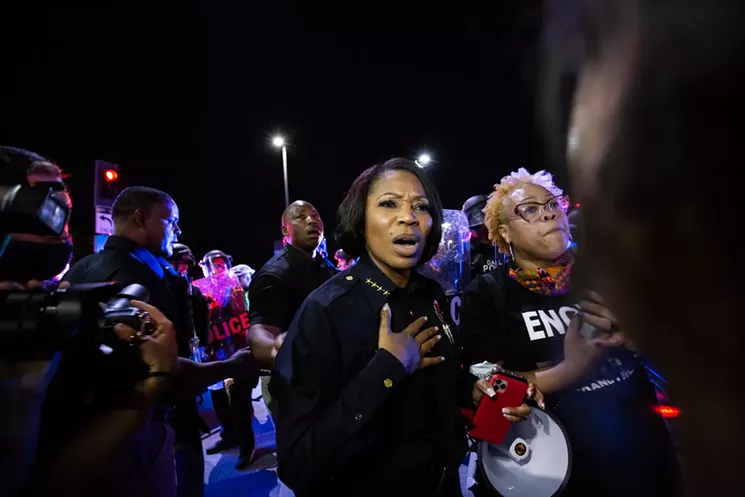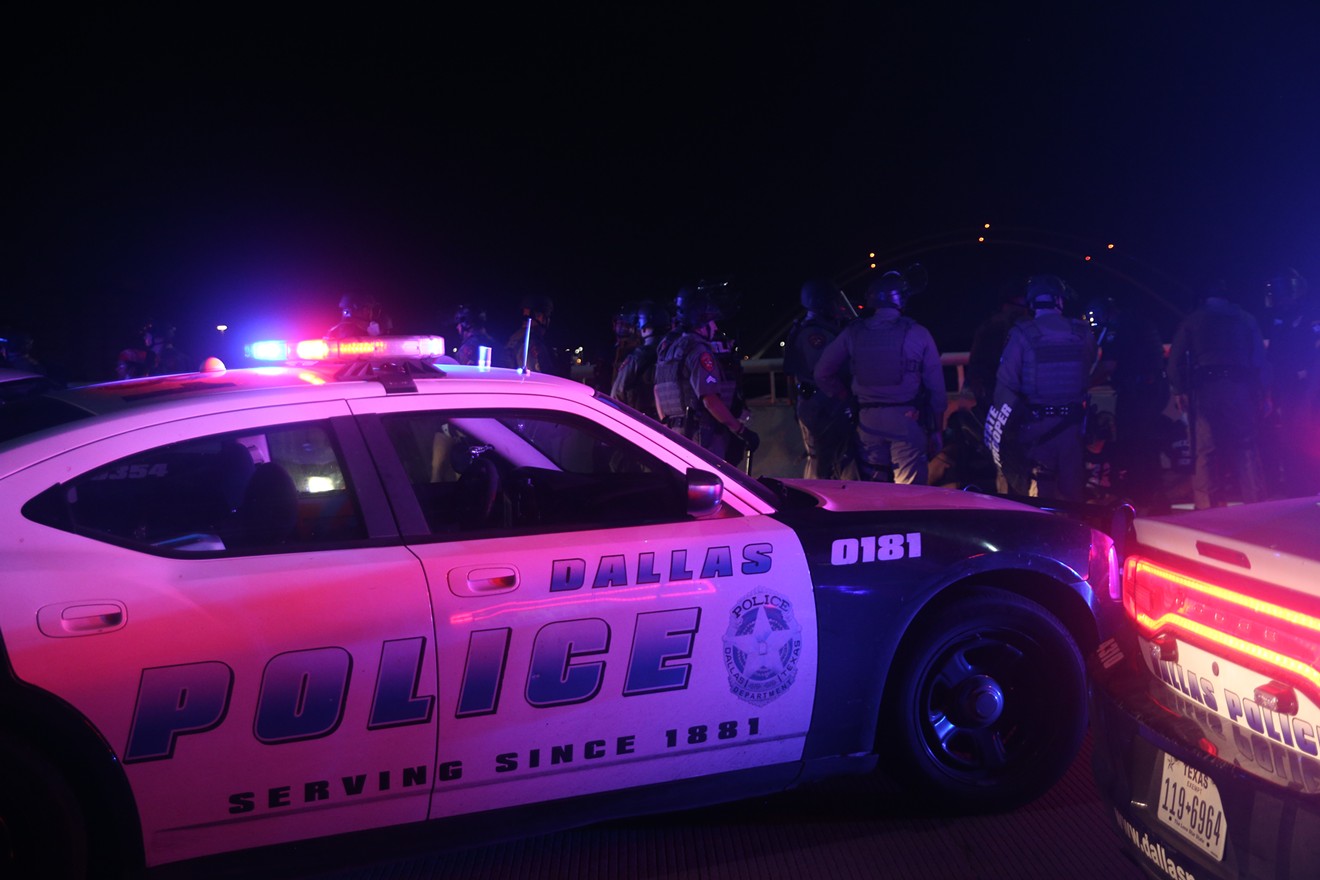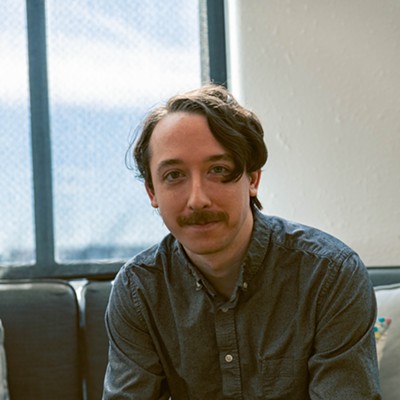Now a cloud of tear gas was still settling as walls of law enforcement officers began to close in on Sasavi and more than 600 other protesters on the Margaret Hunt Hill Bridge. Not far from Sasavi, blood dripped from Pamela Grayson’s head. She says she was hit with a “rubber bullet.”
"After I was shot, I experienced nausea, headaches, the inability to fully function and the knot on my head hurts to this day" says Grayson, who was in the middle of a subdued crowd when she was hit by a "less-lethal" round fired by police.
Officers told the protesters they were being detained for obstructing a highway. As they sat on the bridge, the protesters didn’t know if they were going to jail or going home.
The official report of the Dallas Police Department’s actions on that day, and on the two days of protests before was finally released Friday evening. It includes descriptions of looting and rioting, clouds of tear gas and people wounded by “less-lethal" projectiles. While the report finds errors in communication, planning and management hindered the police response to the protests, it largely lays the blame for violence at the feet of protesters who attacked officers.
The official Dallas Police Department report about its response to recent Black Lives Matter protests was finally released around 7:50 p.m. on Friday
The City Council has been asking for the report since early-June. A preliminary version has existed for some time now and was leaked to the website Central Track, which published it last month.
Now, with the council back from summer recess, Councilman Adam McGough’s patience was wearing thin. McGough, chairman of the public safety committee, issued a memo Aug. 11 calling for a special public safety meeting about the after-action report. He wanted the final or most recent version of the report made public by 4 p.m. Friday. The special meeting is set for Tuesday.
"I am deeply concerned about the inexplicable use of excessive force in several circumstances and lack of requisite planning and strategies to keep our community and protesters safe," McGough wrote in the memo. "These actions must be further investigated and there must be appropriate accountability."
McGough said he would not comment on the report until after the Tuesday meeting.
In the report, the department says these protests were unlike any its officers had ever seen. It claims that in the four days, after thousands of interactions between officers and protesters, there were only two significant injuries to civilians and six officers needed immediate medical attention. The report says other protesters and officers sustained minor injuries, but details of ongoing criminal or administrative investigations into complaints of officers' use of force were excluded.
While the protests appear to have been planned peacefully, the report says, they eventually turned violent. The department attributes some of the violence to "external influencers." The report says DPD positively identified people who are affiliated with the "boogaloo movement," a loosely affiliated anti-government extremist movement associated with white supremacists. It also says they believe people who "sympathize with ANTIFA" were at the protests.
The response to the protests included officers from 17 different agencies.
The May 29 protest, organized by Next Generation Action Network, was documented in photographs by Observer contributor Melissa Hennings. The demonstration drew about 650 people to DPD's Jack Evans Headquarters. The protesters marched to the Dallas Police Association building, and once they left there, the report says, tensions escalated.
When they left the building, the protesters ran into two to Dallas County Sheriff’s Office deputies in an unmarked black SUV. The deputies were blocking an intersection to "protect the participants and residents from motor vehicle traffic," the report says. According to DPD, the protesters surrounded the SUV and became hostile toward the sheriff's deputies.
When DPD arrived to push the protesters back, the report says a group of them began to head toward downtown. Some of these individuals encountered DPD officers at the intersection of Griffin and Young streets. After being told to disperse, a crowd surrounded the officers' cars and began "beating on them and by throwing objects such as bricks and rocks," the report says.
"I am deeply concerned about the inexplicable use of excessive force in several circumstances and lack of requisite planning and strategies to keep our community and protesters safe." Dallas City Councilman Adam McGough
tweet this
At this point, the report says, DPD realized the protesters' intentions shifted from peaceful to violent and officers responded with less-than-lethal tactics, including shooting 40mm sponge rounds and using pepper-ball launchers. When officers became trapped in their vehicles because objects were being thrown at them, DPD's SWAT unit arrived to help.
The SWAT officers pulled up in armored personnel carriers (APCs) and began trying to disperse the protesters with their public address system, but "the use of the PA only seemed to incite the crowd, with some individuals jumping onto police vehicles while others continued to throw bricks and frozen water bottles," according to the report.
The SWAT commander determined that the safest way to "regain order" was to deploy Corson Stoughton (C.S.) gas, commonly called tear gas. According to the report, "This tactic proved successful as the crowd began to move back." The C.S. gas was deployed twice this night to try to control protesters. Then, burglary and looting began.
The department wasn't able to regain control of the area until about 3 a.m. the next day, the report says.
The May 30 protest was organized by the Dallas Alliance Against Racist and Political Repression, National Alliance Against Racist and Political Repression, and the UTA Progressive Student Union.
Ahead of the protest, law enforcement officers identified, located and arrested an individual who claimed he was armed, downtown and wanted to hunt police.
The protest began around 1:30 p.m. at City Hall and drew about 750 people. They marched through downtown and returned to City Hall "without incident," the report says. When they got back, however, the commander there said officers saw a man in a gas mask carrying a rifle being surrounded by protesters.
A response team was thrown together to attempt to extract the man with the rifle. As the response team rolled into City Hall Plaza, they were surrounded by protesters, who DPD alleges began assaulting them. Other offices from various agencies arrived to help the officers.
The report alleges that protesters then started throwing objects at the officers, so SWAT decided to deploy more C.S. gas.
Several people in the crowd were wearing "elbow and knee pads, goggles, helmets and carrying umbrellas (which are used to mitigate the effects of PepperBall launchers and less-than-lethal rounds) and were throwing the gas canisters back at officers," the report says. The SWAT unit continued to us its "less-than-lethal munitions" on the crowd of protesters.

Local activist Pamela Grayson stands next to Dallas Police Chief U. Reneé Hall trying to calm the crowd of protesters before C.S. gas was deployed on May 29.
Melissa Hennings
Two people were seriously injured. Around 5:40 p.m., one sustained an injury to his eye. Five hours later, another was hurt on their cheek. "The circumstance surrounding these incidents are still under investigation by the DPD Public Integrity Unit at the time of this writing," the report says.
Three separate protests were scheduled throughout May 31, the first day of the 7 p.m. citywide curfew. Despite the 137 curfew zone arrests, the report says the tone of the protests had changed from the previous two days. "Specifically, that the majority of participants on this day were committed to a peaceful demonstration," according to the report.
DPD expected to see about 1,000-1,500 people at the Next Generation Action Network protest on June 1.
The event was moved from its original location to the Frank Crowley Courthouse, which, at the time, was just outside the curfew zone. The crowd gathering at the courthouse quickly grew to more than 700 people. According to the report, a sergeant learned from the event's organizer that the plan was to march around the courthouse. The report also claims the sergeant told the event organizer that any attempt to march on the freeway over the Margaret Hunt Hill Bridge would result in arrests.
Speakers at the event warned protesters about possible mass arrests.
Around 8:40 p.m., protesters began marching northbound on Riverfront Boulevard. Then, they headed toward Woodall Rodgers Freeway and the westbound entrance ramp to the Margaret Hunt Hill Bridge. The report claims that officers were staged at the base of the ramp, instructing protesters not to enter the bridge. "The DPD commander on-scene used a loudspeaker to inform the protest leaders that the crowd would be arrested if they entered the freeway," the report says. DPD Chief U. Reneé Hall has repeated this claim on numerous occasions.
Grayson says this claim is "a bald-faced lie" and calls the whole report a façade. She says her videos from that night show that nothing was blocking the march from entering onto the bridge.
In video and audio of this event captured by the Observer, officers can only be heard instructing protesters not to approach them and to keep moving. Dominique Alexander, the founder of NGAN, said officers did not tell the protesters he was leading to get off of the bridge until they were already boxed in.
In the report, DPD claims that "approximately 150 protesters followed officers’ lawful orders by turning around and exiting the bridge." But, by the time many protesters tried to turn around to get off the bridge, they were met by another wall of police, blocking off their only exit.
Officers shut down both directions of the bridge because some people started hopping to the eastbound lanes. The report also claims that protesters on the bridge began throwing objects at officers after being asked to stop. The officers responded with pepper launchers to try to create a barrier between them and protesters. SWAT team members arrived and began deploying "less-than-lethal munitions," smoke canisters and C.S. gas. This was, again, an attempt to create a barrier between officers and protesters, the report says.
Protest in Dallas June 1.
Jacob Vaughn
This is the sound of mistakes being made by law enforcement on the Margaret Hunt Hill Bridge June 1.
Some protesters and members of local media were hit by projectiles being shot at them by police. As chaos erupted on the bridge, some protesters tried to carry the injured to safety. Local journalist Steven Monacelli, the publisher and editor for Protean Magazine, was covering the protests for Dallas Voice.
Monacelli was at the front of the march when police first started firing projectiles and releasing C.S. gas. He said the first shots, which he captured in this video, were pepperballs and appeared to be aimed at a photographer. He did what he usually does: He stood his ground, did everything he could to identify himself as a member of the press and continued documenting as long as he could.
Eventually, he was overwhelmed by the gas and retreated into the crowd. After rinsing himself off, he made his way back to the front as the crowd walked in the opposite direction. He was with a group of reporters when he was shot with what he suspects was a tear gas canister, which left a bruise on his leg that covers more than half of his thigh. As he retreated, he was shot in the back with a green paintball.
Monacelli believes the paintball was meant to mark him for questioning because, despite all the indications that he was a member of the press, he was detained for hours and arrested. Press Freedom Tracker covered Monacelli's experience.
Water bottles were thrown toward officers on the bridge, but Monacelli doesn't know whether any were frozen. He interprets the report's emphasis one the bottles being frozen as a way to make it seem as though protesters showed up planning to inflict harm. (He says he grabbed a partially frozen water bottle from a medic tent the day before.) Even if the bottles thrown toward officers on the bridge were solid chunks of ice, Monacelli says, the police response was not proportional.
After the gas was deployed, people began calling Hall to complain about how the situation was being handled. According to the report, the chief called the event commander and ordered that C.S. gas was not to be used. "Each deployment of C.S. gas was made prior to directions being issued from the Chief," the report states.
Nearly 700 people were detained on the bridge. Several factors, including the knowledge that at least one protester was positive for COVID-19, led the department to release those arrested.
The department, as well as the Office of Community Police Oversight, is investigating 50 use-of-force complaints from the four days of protests.
According to the report, $5 million worth of damage was done to the central business district and DPD incurred $3 million in costs. On the costs, Grayson refers to local victims of police violence: "What was the cost to Santos Rodriguez's, Botham Jean's, Tony Timpa's and all the other families for the damage done by DPD?" she said. "It is well beyond these ... costs."
In a statement released Saturday, Dallas Mayor Eric Johnson said he was deeply concerned about the "lack of leadership, the failure of planning and the miscommunication" detailed in the report. He added, "It raises further questions about the police commanders' decision-making and contains at least one statement that I personally know to be false."
Johnson did not go into detail about the falsehood. Tristan Hallman, his chief of policy and communications, pointed out on Twitter that the report incorrectly states that Johnson held a press conference announcing the curfew, when in fact it was Hall who held the conference.
Hall has defended her officers' actions, but in an exclusive interview with The Dallas Morning News on Friday, she said the department made some mistakes. In the interview, Hall said the report would call attention to “some of the missteps that we made, acknowledging them and moving forward to fix them.”
In the weeks following the protests, the police department has restricted its officers from using "less lethal" weapons and tear gas on crowds of peaceful protesters. The department changed its general orders to allow the release of bodycam footage within 72 hours of critical incidents. Additionally, DPD hopes to get 500 new body cameras for all officers interacting with the public to wear.
But members of the council have repeatedly questioned how the protests were handled. Last week, Johnson said he was extremely disheartened by the DMN's investigation into a photo taken during a protest on May 30. The photo shows a Dallas police Sgt. Roger Rudloff shooting a protester with pepper balls from just a few feet away. Hall told the News that Rudloff is being investigated by the internal affairs division.
In her interview with the DMN, Hall said: “Real change is hard — taking a look at what you do and how you can be better. If you don’t acknowledge those things you don’t do well, you can never truly change the police department.”
Three days after the June 1 protests, the department decided to drop the charges against the activists.
Until the City Council has its chance to question police leaders and DPD resolves its use-of-force complaints, activists like Grayson and Sasavi will be left wondering if anyone will be held accountable for the wounds they sustained and tear gas they inhaled.












